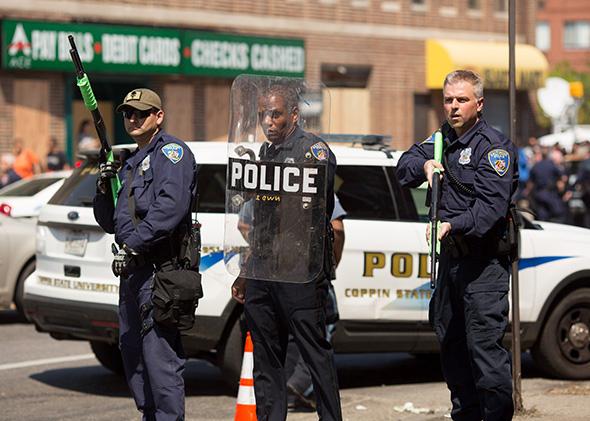You have a choice: You can have brutal, abusive policing. Or you can have no policing at all.
That’s the implied message from the Baltimore police officers engaged in a deliberate slowdown, which started after prosecutors charged six of their colleagues in the death of Freddie Gray. Across the city, resident say, there are fewer police on patrol, fewer cops on the corner, fewer people on the beat. “They’re not coming because they’re afraid,” said one man in an interview with NPR. He says police have ignored dozens of calls about drug dealers in his neighborhood. Other Baltimoreans echo his claims: “People wake up with shots through their windows. Police used to sit on every corner, on the top of the block. These days? They’re nowhere.”
Evidence of the slowdown is in the arrest rate. From April to May, arrests declined 43 percent, bringing arrests down to their lowest point in three years. The year-over-year figures are striking: A force that arrested 3,801 people in May of 2014 arrested just 1,177 people in May of 2015.
Less policing has meant more crime, especially in the violent neighborhoods of East and West Baltimore. There were 42 homicides and 100 shootings in May, making it the single deadliest month—in absolute and relative terms—since 1971. Shootings are up, as are assaults and other violent crimes.
For their part, police leaders say officers are still at work but fear prosecution and public attack. “What is happening, there is a lot of levels of confusion in the police organization,” explained Commissioner Anthony Batts at a City Council meeting last month. “There are people who have pain, there are people who are hurt, there are people who are frustrated, there are people who are angry. … There are people, and they’ve said this to me, ‘If I get out of my car and make a stop for a reasonable suspicion that leads to probable cause but I make a mistake on it, will I be arrested?’ ”
On social media, President Gene Ryan of the Baltimore Fraternal Order of Police Lodge 3 declared that police feel “under siege.” “The criminals are taking advantage of the situation in Baltimore since the unrest,” Ryan wrote. “[Police] are more afraid of going to jail for doing their jobs properly than they are of getting shot on duty.”
If Baltimore police believe “doing their jobs properly” requires rough rides and other abusive behavior, then they should be in jail. Despite this, pundits—like Heather Mac Donald of the Manhattan Institute—have echoed this claim, decrying a “crime wave” sparked by protests against police brutality. The “most plausible explanation of the current surge in lawlessness,” she writes, “is the intense agitation against American police departments over the past nine months.” Her argument, published last month, was debunked by a cadre of reporters and criminologists, who dinged her for specious reasoning—short-term blips in crime aren’t a “wave” or “surge”—and statistical malpractice. And a recent report from the Sentencing Project—using St. Louis as the case study—finds no evidence of a “new crime wave” and little evidence of a “Ferguson effect” tied to protests of police practices.
To go back to Baltimore, it’s not that criminals have taken advantage of protests, it’s that police—in their virtual strike against the city—have exacerbated a real and serious crime problem, in service of a false choice between two kinds of lawlessness: One where violent, aggressive cops reign, and the other, where criminals do.
The fact is there’s a third option. In the wake of the April unrest, Baltimoreans demanded better, more humane policing. They wanted cops on the street, but didn’t think that should come at the cost of their rights, or their lives. It’s not just a reasonable request, it’s the core idea behind “community policing” programs: That you can keep communities safe and hold bad police accountable for criminal behavior.
In cities as different and diverse as Camden, New Jersey and Seattle, police have worked with communities to improve relationships, discipline bad actors, and—most importantly—reduce crime. There’s no contradiction. A city where officers and citizens can work together is one where there’s goodwill. Incidents still happen, but they’re mediated by pre-existing relationships and open lines of communication.
When Maryland state’s attorney for Baltimore Marilyn Mosby charged the responsible officers with Freddie Gray’s death—when she held them responsible—she helped create an opportunity for new, more constructive relationships between the city, the police, and the community.
With the slowdown, police are squandering that opportunity. By treating the city and its residents as a force to be beaten, these officers are sowing anger and animosity among potential allies. The Baltimore riots—the despair, the violence, and the destruction—were tragic, but if the city can’t learn from them—if it’s stuck in this ill will and resentment—they’ll become an actual tragedy.
